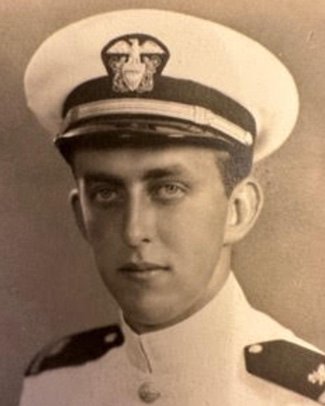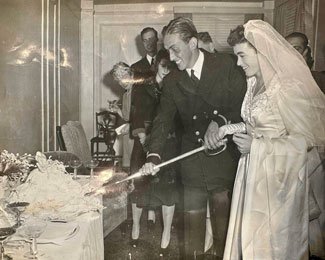It Took a Lifetime to Learn My Father’s War Story—and How It Shaped Us Both
This is Part II of a two-part story. Read Part I.
My mother had told me that Dad handled payroll for his ship, the USS Hughes, and its sister ship, the USS Hammann. I imagined that he had somehow sailed through the Battle of Midway performing an administrative role and, therefore, safe from danger; I did not understand that officers had many nonmilitary duties that kept the business of these ships going. But if there was a battle, they were all in “battle stations,” not at a desk and a ledger.
Like many children of World War II veterans, we knew so little.
Years later, the gravitational pull of an airport exhibit finally drew me toward my father’s story. After two decades of dashing down Midway Airport’s Concourse A in Chicago, keeping up with the human tide, I began to slow my pace—a slight pause, a glance to the side, as I noted the museum-quality display of the Battle of Midway that sits in this corridor. It is a multimedia exhibit, including video footage, timelines, and photographs of beautiful, brave young men. One of the dive bombers is suspended overhead. As quickly as I saw it, I would move on, absorbed in the flow of travelers, the images of war or some vague thought fading from consciousness, evanescent.

Sally Carton’s father, Sandy Blodget, in his Navy uniform. Photo courtesy of the author.
Then, for another five years, I took to stopping at the exhibit—over and over and over. I wouldn’t have said that I wanted to know more. I just stood there with this compelling feeling that I was looking for my father, as though his face would emerge from the black-and-white photos of Navy men aboard ships and planes, or I might locate his obscure ship in one of the vast scenes of the naval flotilla steaming west towards the Japanese.
I was like those characters in a sci-fi movie who turned silently toward some unseen destination, gazing, transfixed, while my husband or kids disappeared around the corner toward our gate.
Huh, I’d think, and walk on. A longing was wrapping its tendrils around me.
I started reading books and watching war movies about Midway, looking for a destroyer called the Hughes. It was never mentioned. I knew that his ship had some connection to the sinking of the aircraft carrier USS Yorktown, but the movies and the exhibits focused more gloriously on the sinking of Japanese ships and the valor of fighter pilots.
Over these years my mother did tell me what happened. I heard it but I didn’t. And then, last year, I went online and began reading naval records related to the sinking of the Yorktown. And there they were: The Hughes and the Hammann. Only the Hughes would survive.
On June 4, 1942, after a series of direct torpedo hits, the massive Yorktown was on fire, without power and listing to one side. Her fleet of ships encircled her to screen her from the enemy while the Hughes and the Hammann were charged with salvage and rescue efforts. Nothing went as planned.
After hours of rescuing sailors from the water and fighting the on-board fires, the Hammann tied up alongside the disabled Yorktown. Men boarded the ship and began to jettison the heavy guns and equipment to lighten her load and prevent her from tipping further. My father’s ship, the Hughes, patrolled nearby. No one detected the Japanese submarine trailing the fleet, its sights on the damaged aircraft carrier. Four torpedoes were fired, and two hit the Yorktown and the Hammann. The Hammann was split in half and began to sink rapidly. She would be gone in no more than four minutes. The men on board were ordered overboard to save themselves. What ensued was a scene of terrible slaughter.

Sally Carton’s parents on their wedding day, shortly before her father headed off to fight in the Pacific. Photo courtesy of the author.
Like all ships of the time, the Hammann was armed with depth charges, drum-like underwater bombs that would be dropped from the ship’s deck to hit enemy submarines that threatened from below. As a depth charge sank, the increasing water pressure would detonate an underwater blast whose concussive force could bend a submarine. Many believed the depth charges on the Hammann had been taken off safely. As the men jumped from the sinking ship, beneath them the metal drums silently dropped to their trigger depth. The ensuing blasts, just minutes after the men jumped overboard, killed everyone in the water—81 souls dead or missing. My father, on the deck of the Hughes, watched helplessly as these men, many of them friends, were annihilated.
A colleague once told me during my years of training as a psychotherapist that a traumatic event is like a loaf of bread—a physical mass that starts in one place and ends in another. We can hold it, point to it, weigh it. This is the awful thing that happened to me. But within every trauma, every loaf, there is one slice that is worse than all the others. Sometimes, we can get to it. Sometimes, we can’t. But we always know it is there. My father did not suffer the agonies of post-traumatic stress disorder, but he carried the bread. And he found a way to try and repair that part of himself.
Award-Winning Journalism in Your Inbox
Every summer, in our lovely protected bay, he pulled men out of the water, stopped boats from sinking, towed them to safety. We repeat things from our past because we hope for a different outcome. Like all of us, he could not undo what was done, but he could have agency; he could act and protect and save. And he was good at it.
I think I understand now, too, why he had a good laugh as he turned our boat into the waves, tossing me side to side. He could laugh at my fear because it didn’t belong to him. That is projection in a nutshell. It is not a conscious strategy, but one of the many ways we survive the things that have wounded us.

This diorama by Norman Bel Geddes depicts the explosion of depth charges from USS Hammann as she sank alongside USS Yorktown on the afternoon of June 6, 1942. Both ships were torpedoed by a Japanese submarine while Hammann was assisting with the salvage of Yorktown. USS Vireo (AT-144) is shown at left, returning to pick up survivors, as destroyers head off to search for the submarine. Photo by the U.S. Navy, courtesy of the National Archives.
One hot day way offshore, Dad pulled up alongside the enormous red metal bell buoy that rocked in the ocean swells. Dad gleefully urged me to climb on up the 20-foot bell tower for a great jump into the water. It was a lark and it felt daring. I grasped the rings jutting from the buoy’s massive base and clambered up, the thick orange life preserver offering some protection from the huge rivets. I stood. Then, with a laugh and a wave, my father took off, leaving me there as his boat headed toward shore. I felt it again, that tilt in the universe where fun turned to fear, and I gripped the struts as his boat grew smaller in the vast sea.
To this day, three generations of my father’s descendants have delighted in that caper. But I never saw it coming.
I don’t believe that I ever thought that he would not return. In fact, the coming back was the point. And shortly, he returned at full throttle to rescue me from my rolling perch, delighted and triumphant. His wide smile and sparkling eyes told me I was safe and loved, but also not understood. His blind spot, it turned out, was his children’s fears. I was the daughter who learned to laugh along.
On that day on the bell buoy, I jumped in the water and climbed back into the boat. Wrapped in a towel as we headed for home, flying across the glassy waters of the bay, I couldn’t yet understand that his ghosts had taken up residence in me.
* * *
In 1986, long before I had started down this path of discovery, and four years before my father died, my dear friend Lisa married a man named Joe Lovering. “Lovering!” my father exclaimed. “Ask him if he had a relative on the Hammann. He was a friend of mine.”
Our Journalism Depends on Your Support
He did—his great uncle, William Lovering. I confirmed this news to my father, and, sadly, fully preoccupied with my 20-something interests, I never stopped to ask more. My father gave a big laugh at what a small world this is. Nothing asked, nothing volunteered.
This past winter, I visited Lisa and there, on the wall of a house I had never been to, hung the portrait of her husband’s great uncle, my father’s friend, who had died in the sinking of the Hammann.
This War Horse reflection was written by Sally Carton, edited by Kristin Davis, fact-checked by Jess Rohan, and copy-edited by Mitchell Hansen-Dewar. Abbie Bennett wrote the headlines.





Comments are closed.